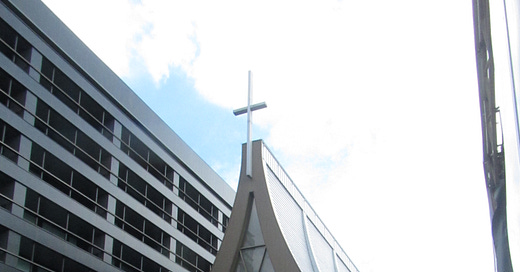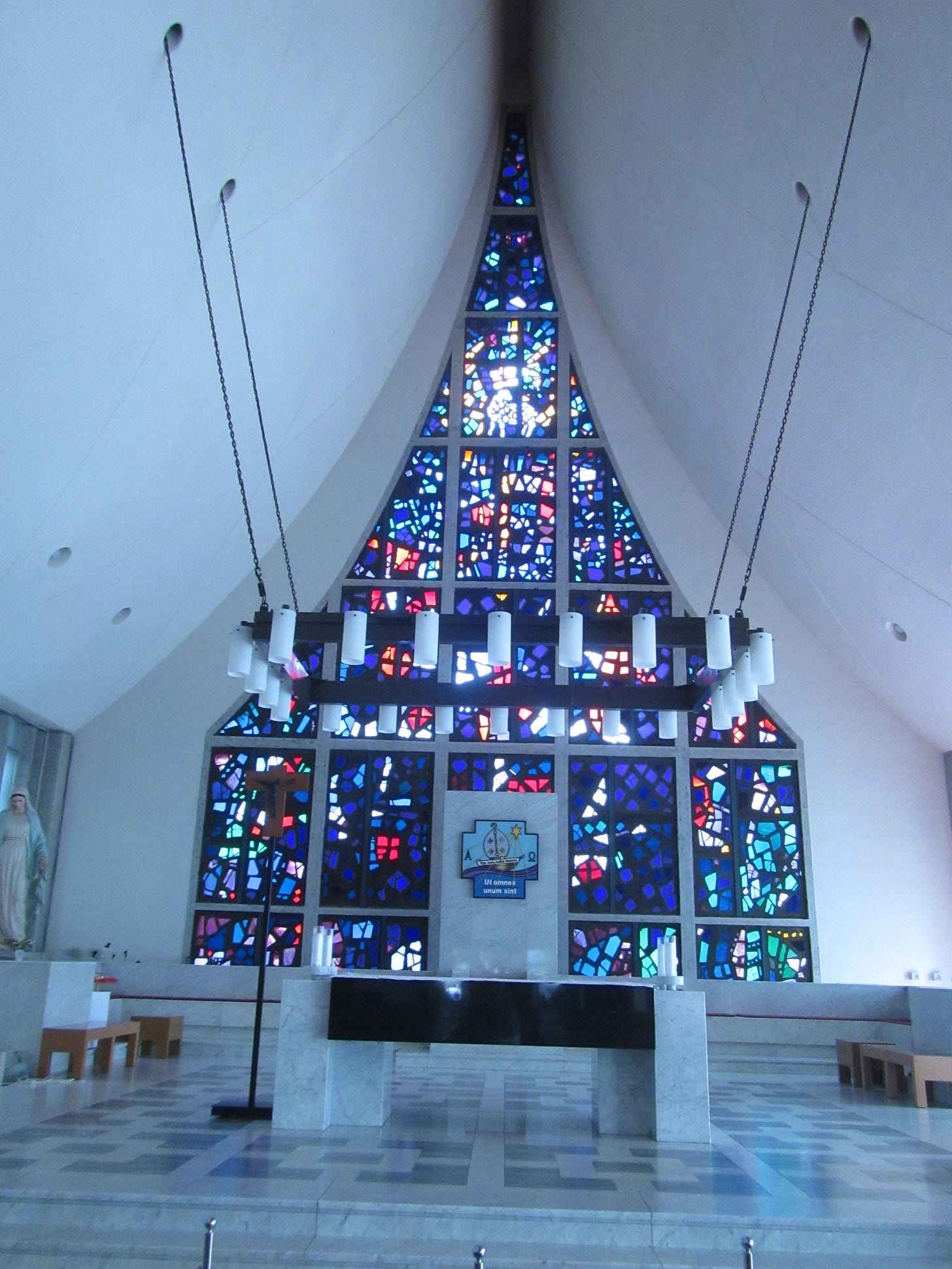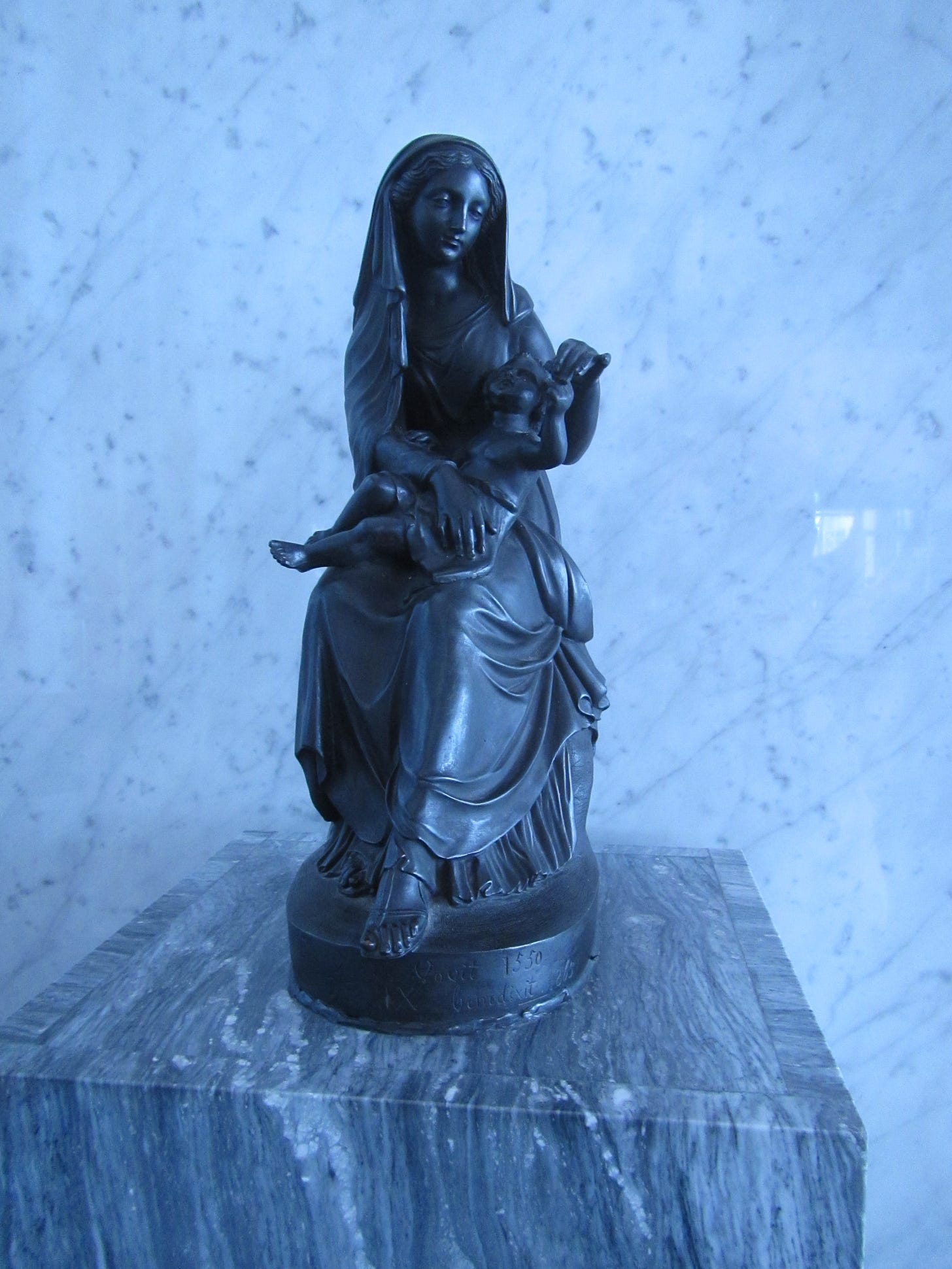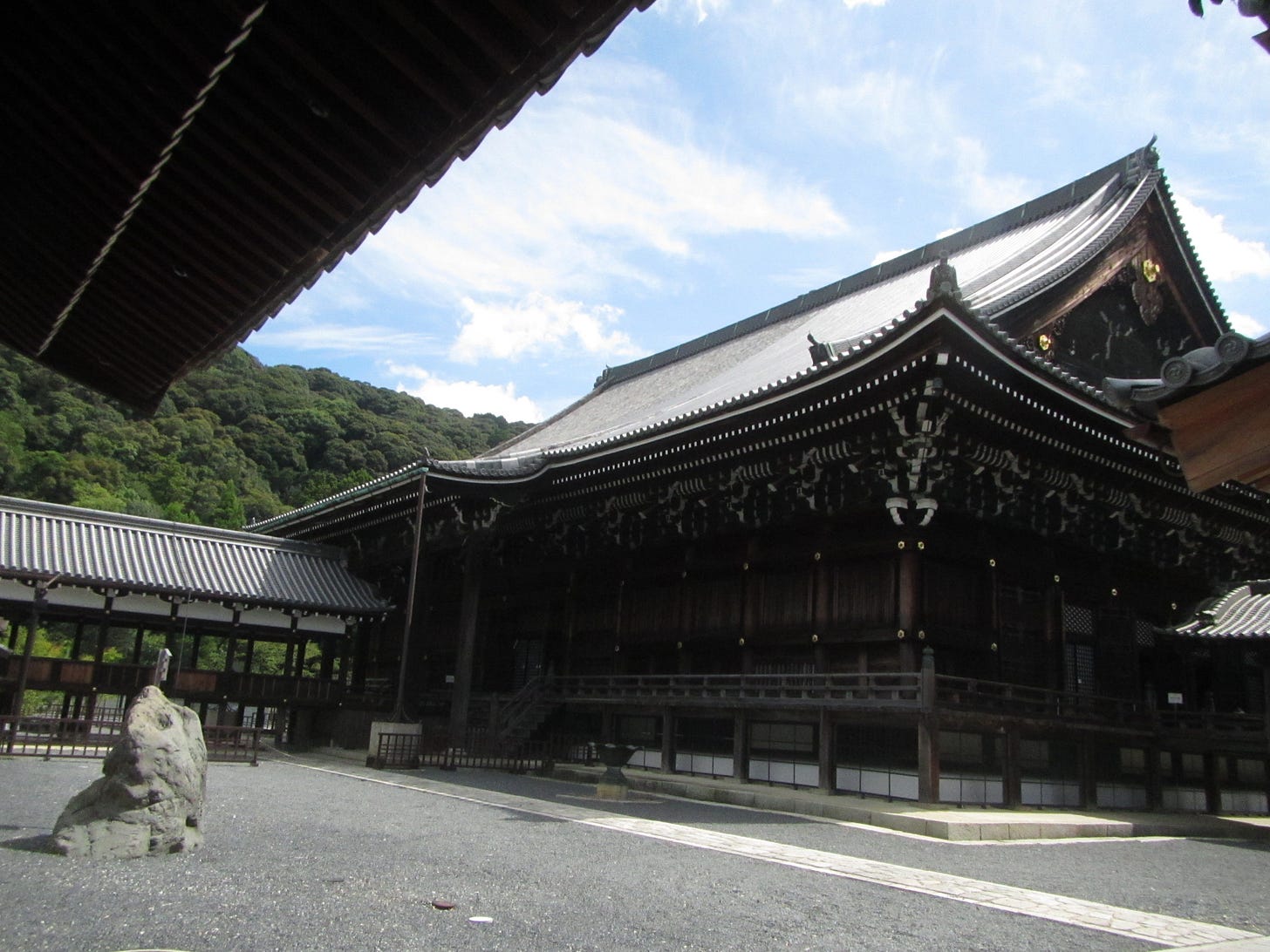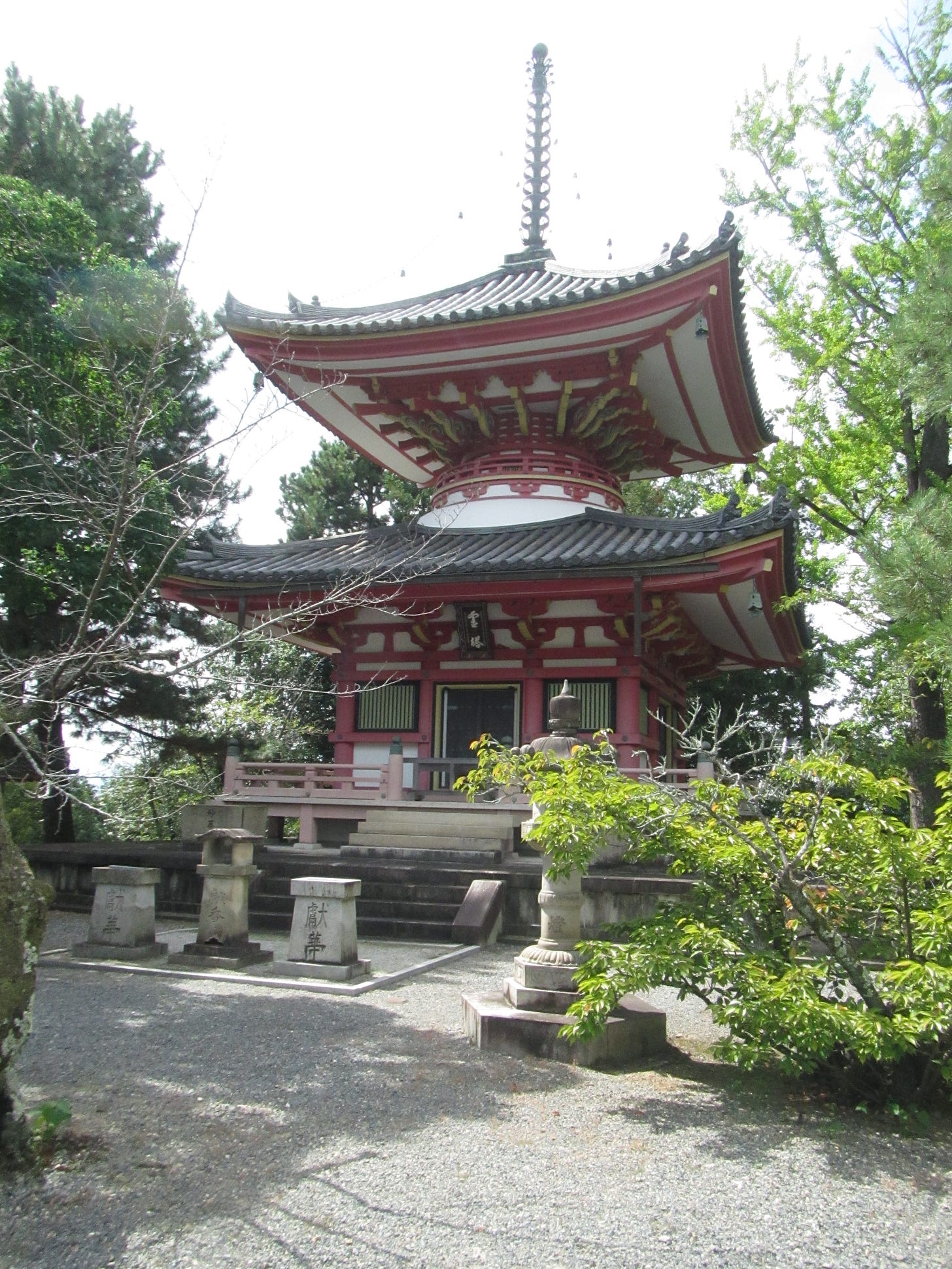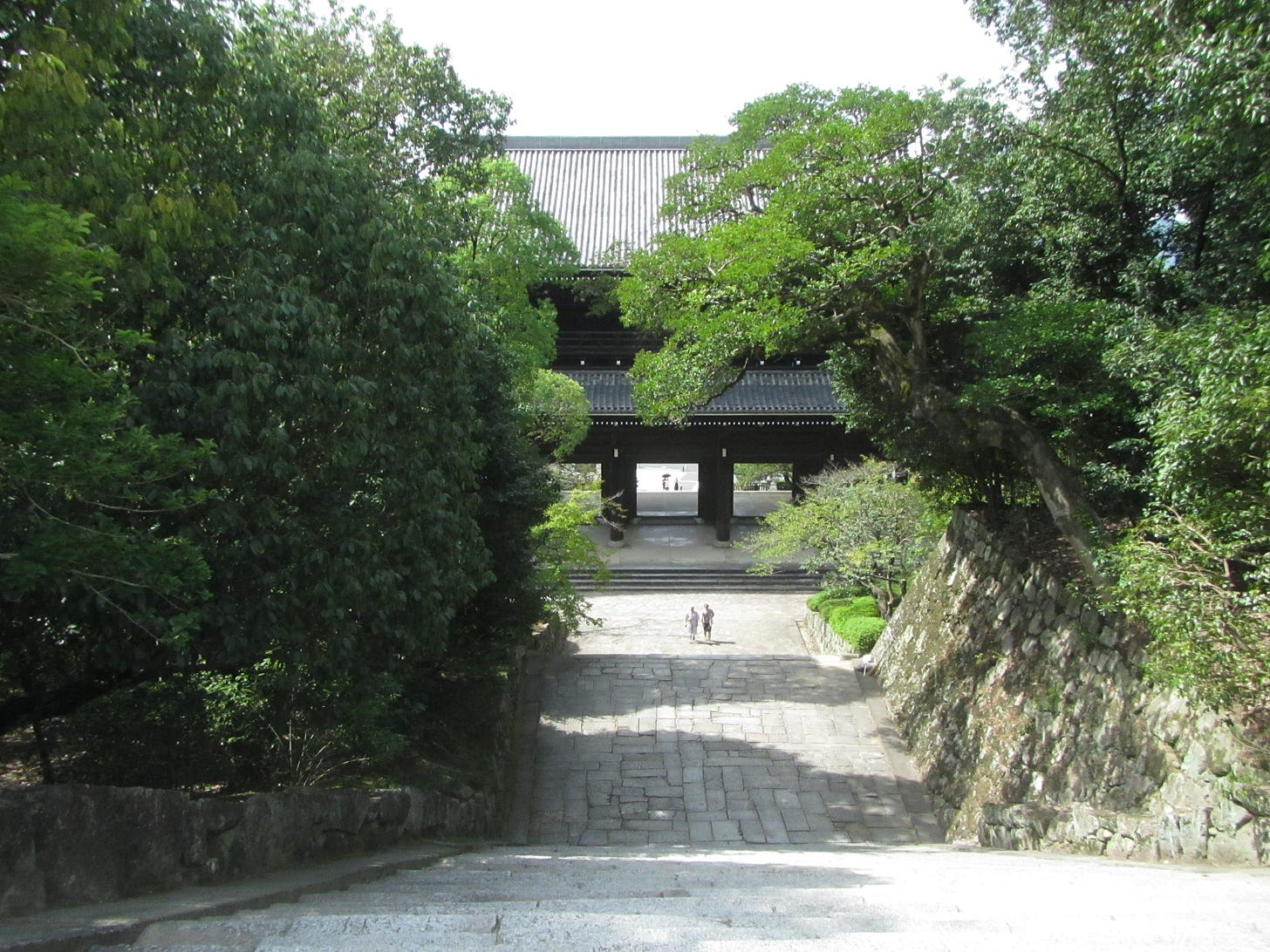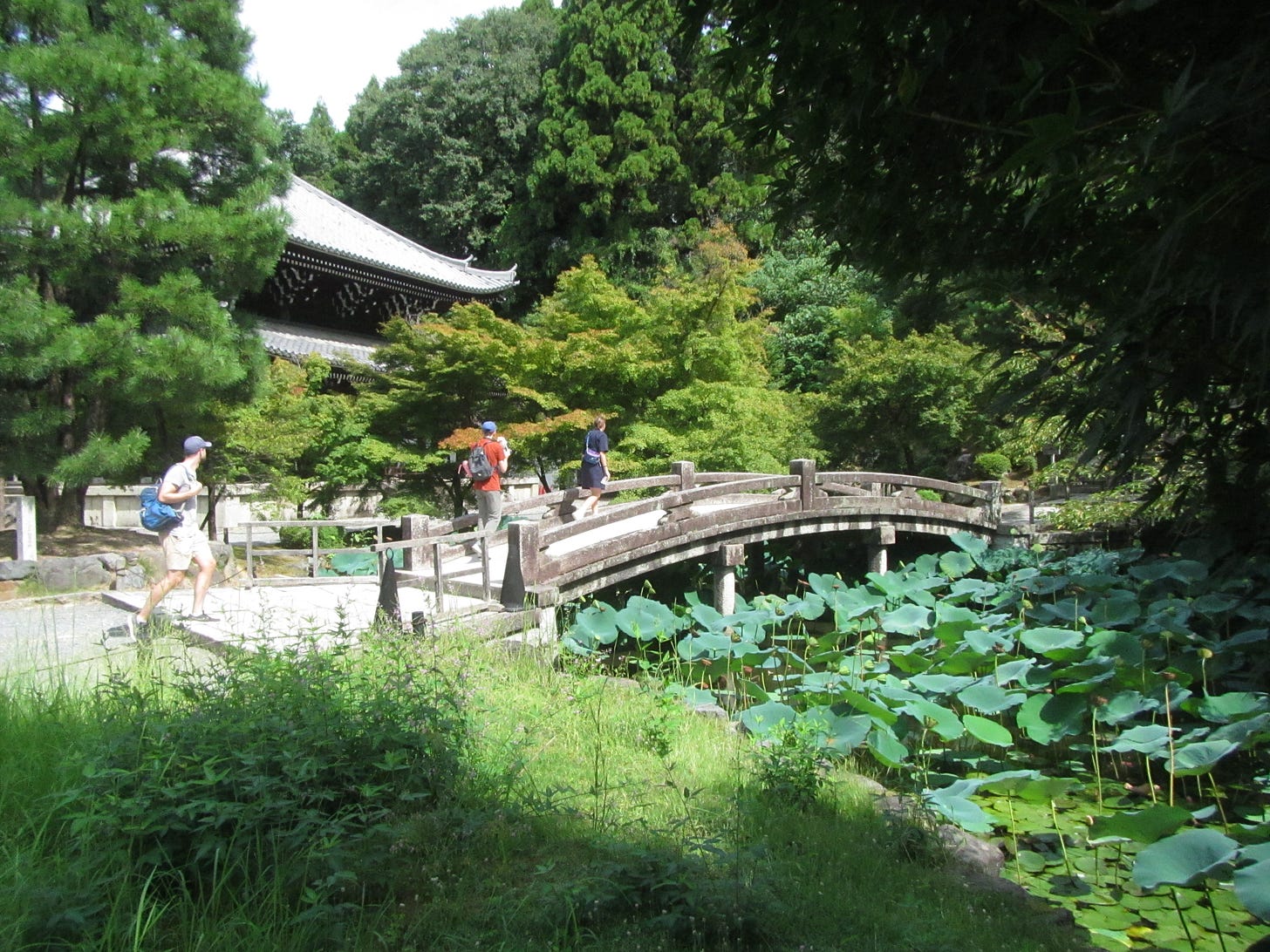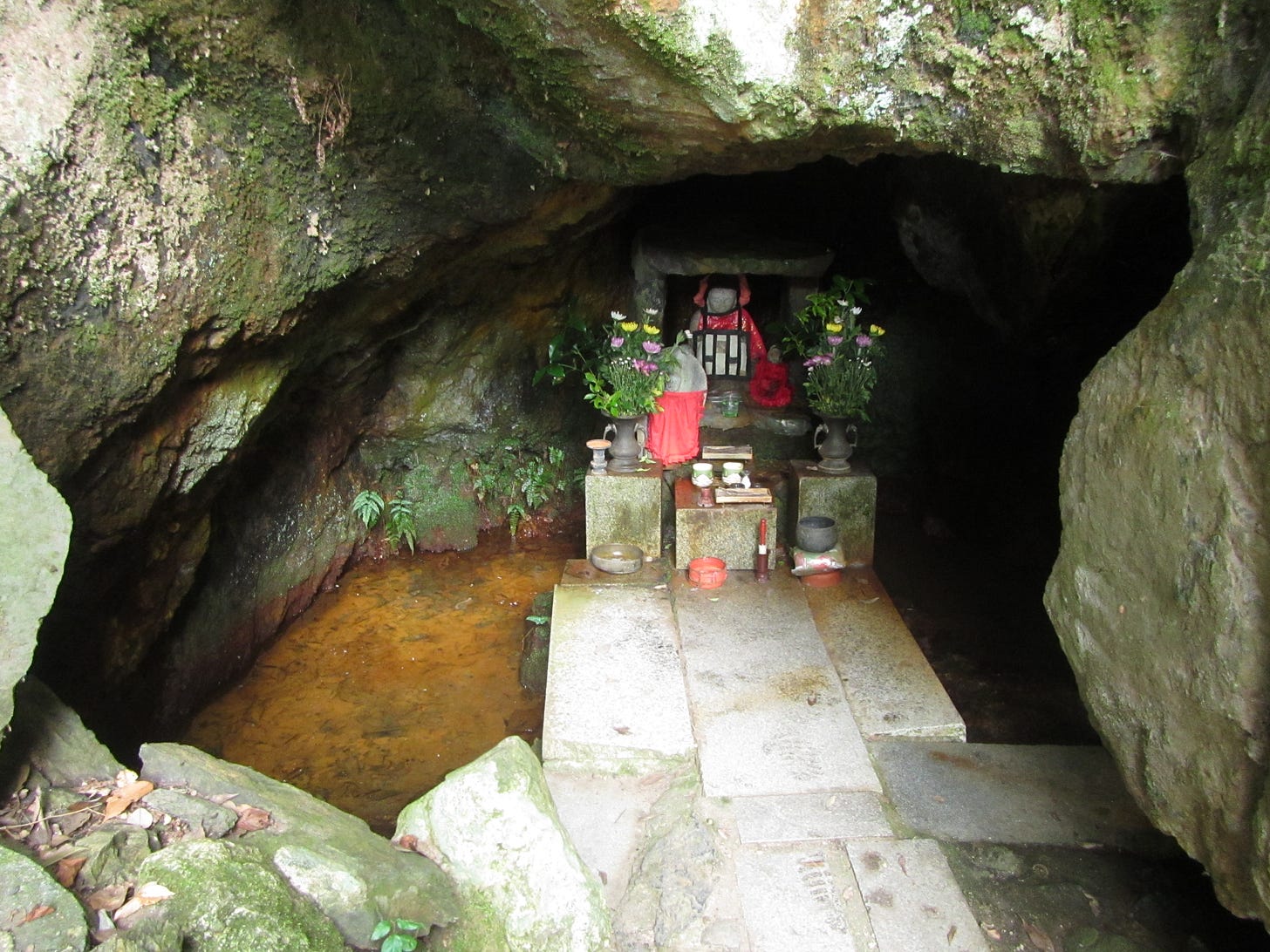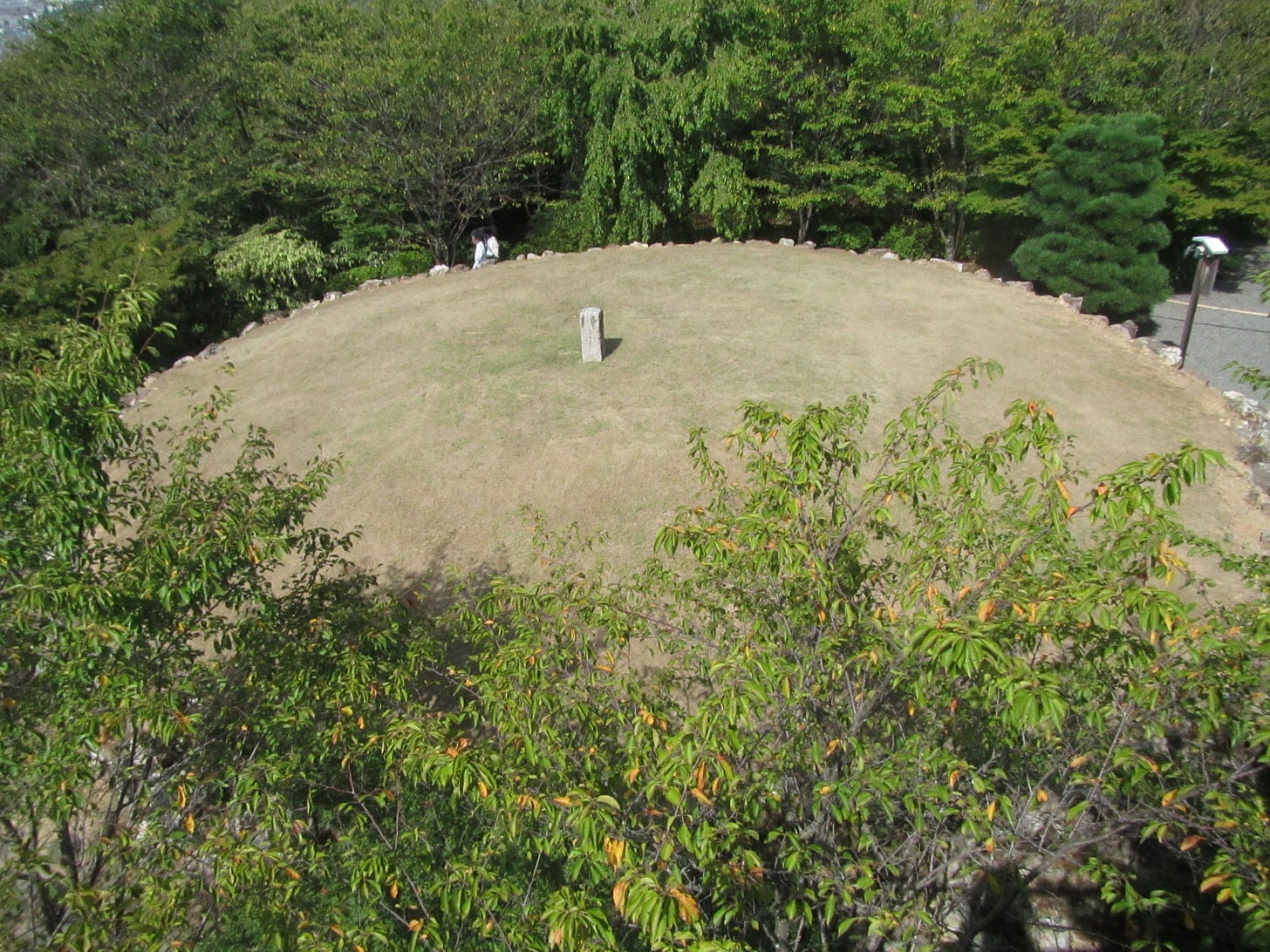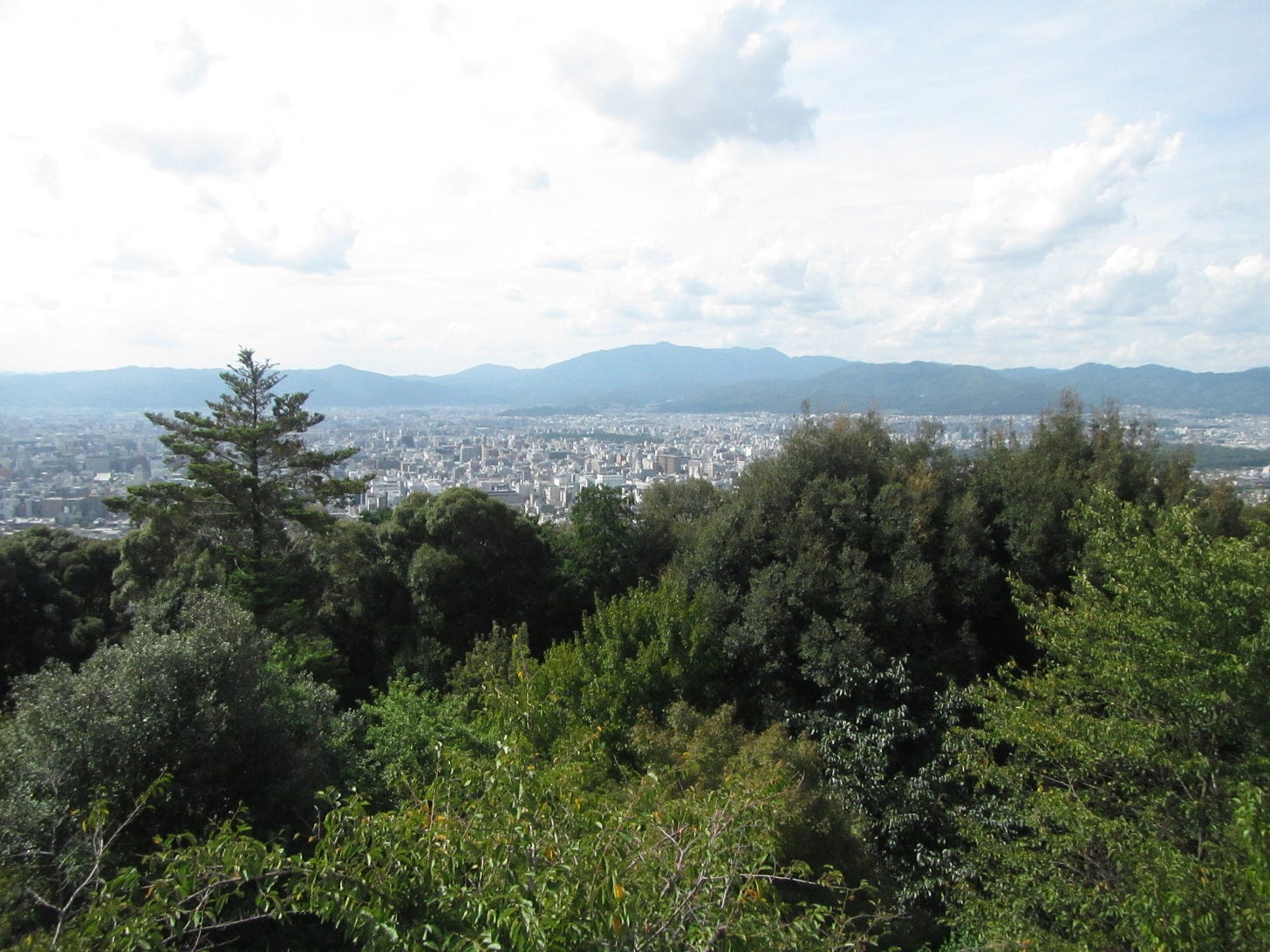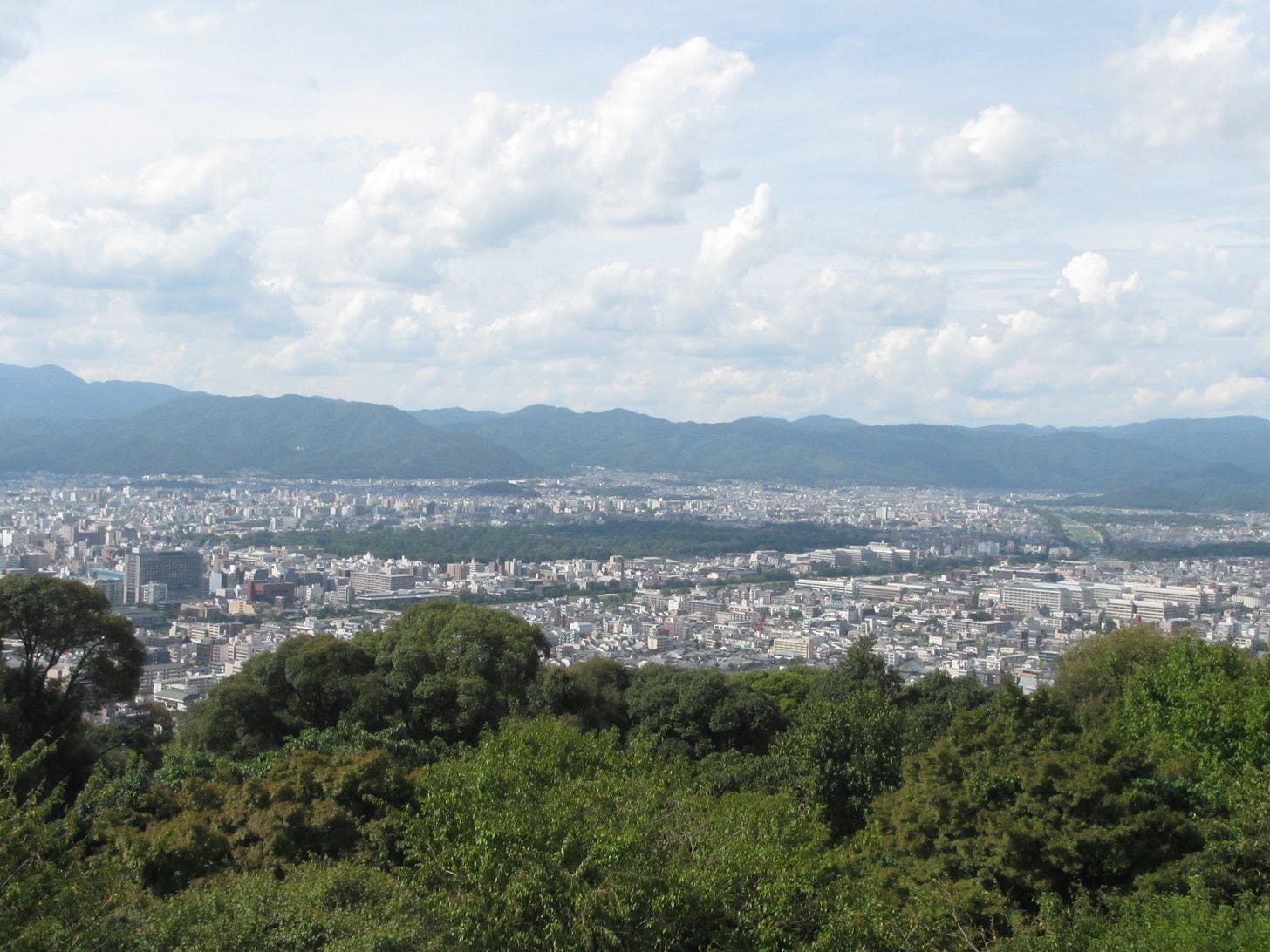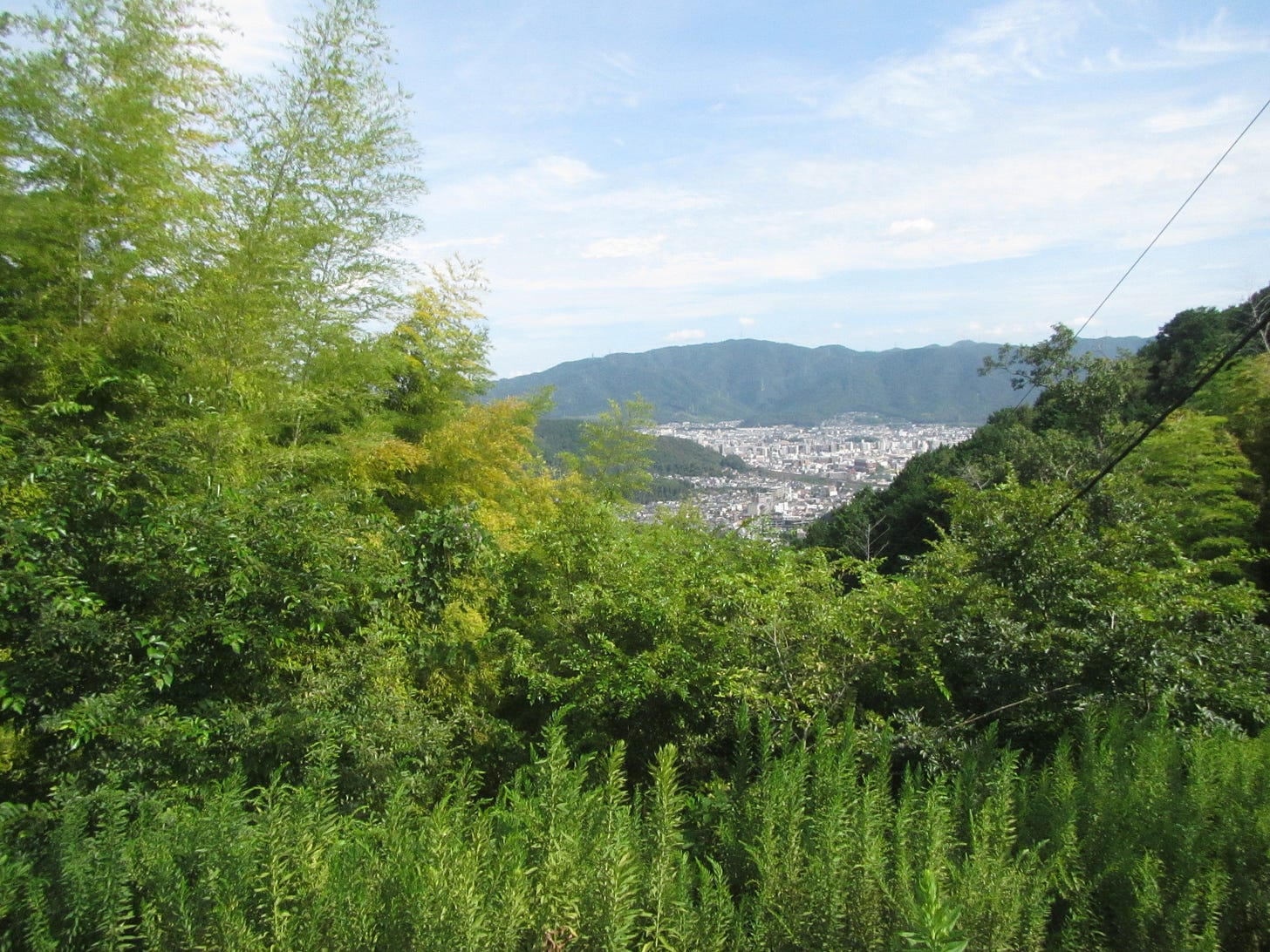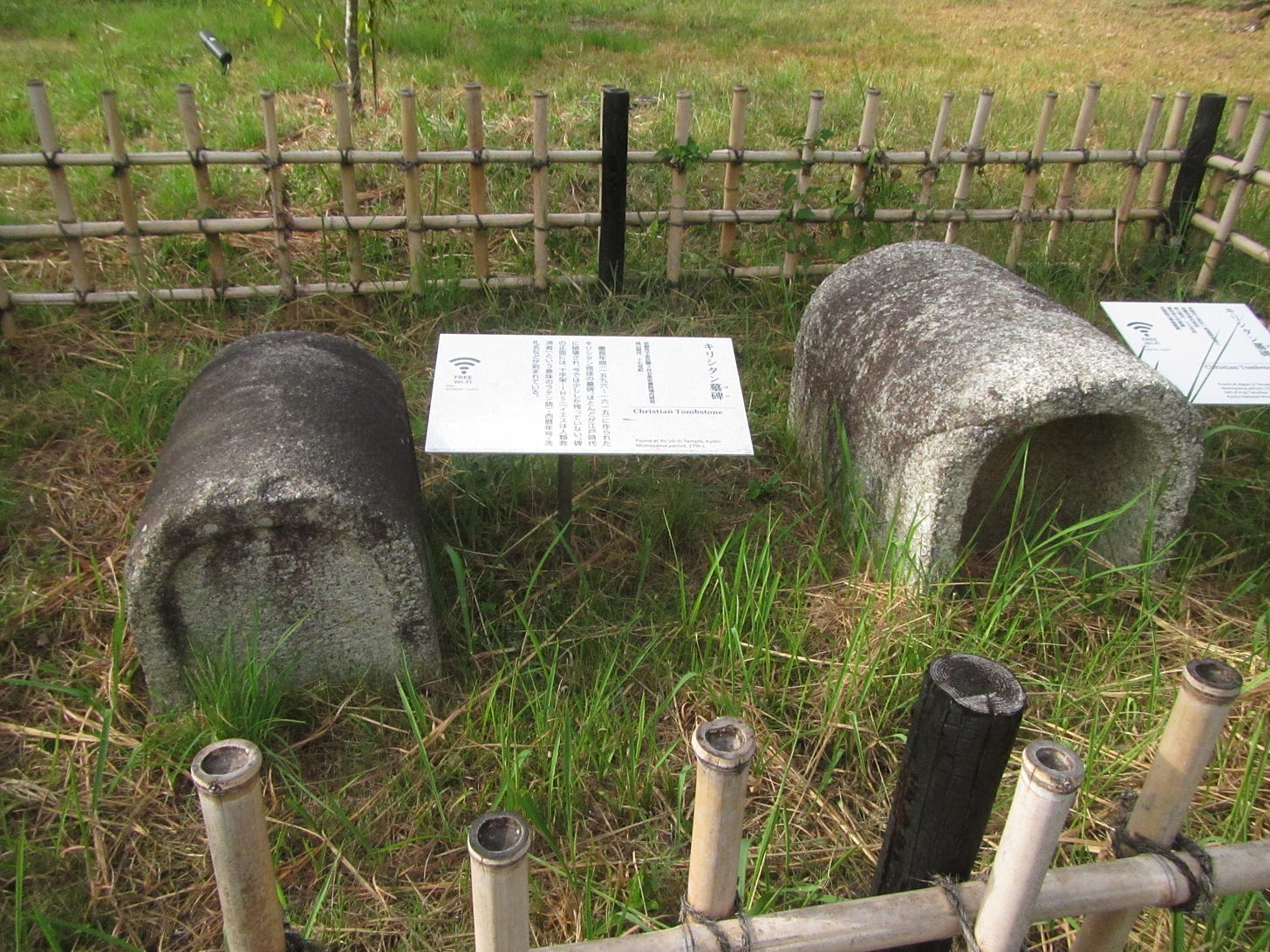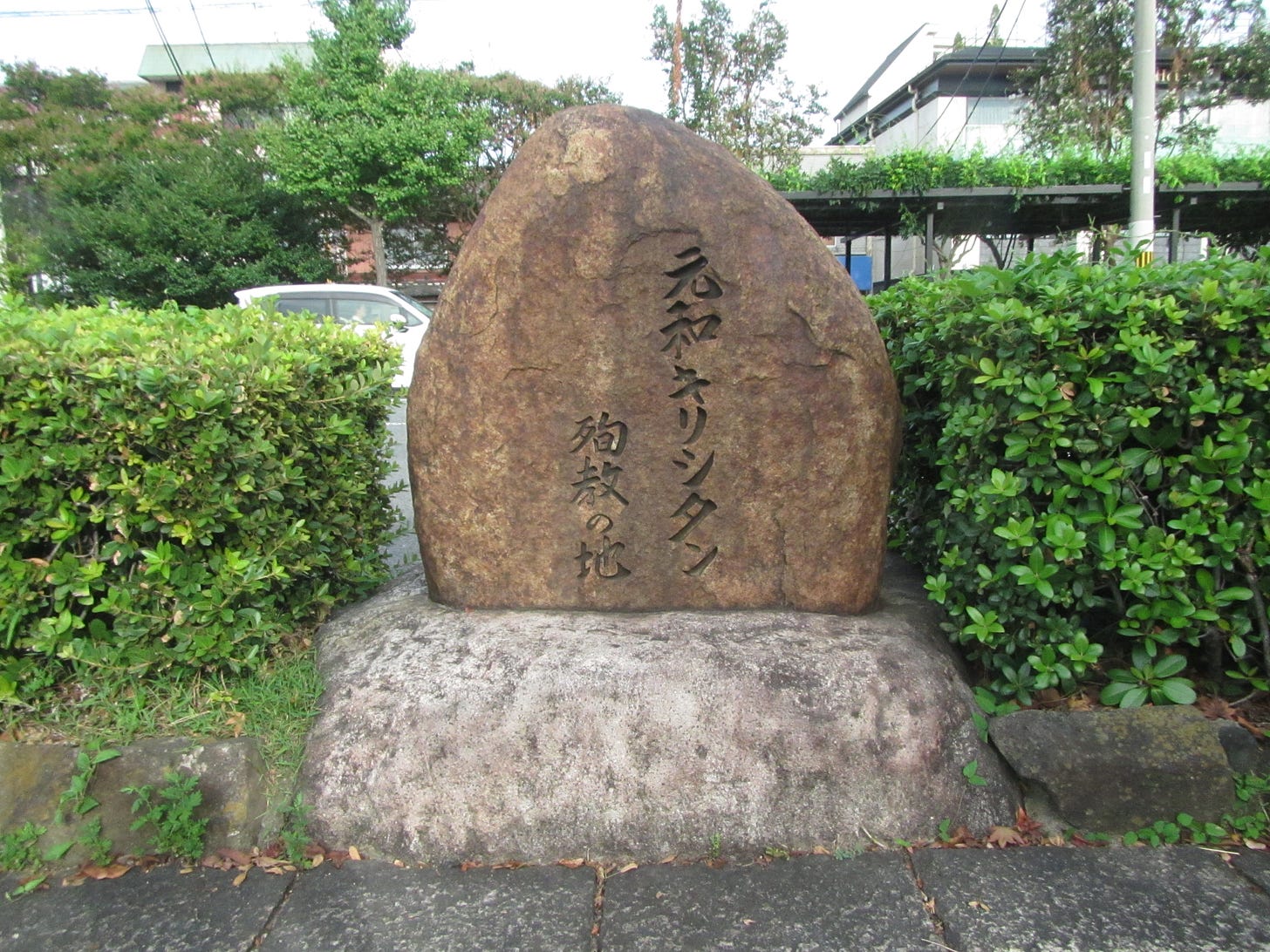A cathedral, a missionary, a burial mound, a statue, a dragon, and an emperor
Today’s walk begins at Kyōto Catholic Cathedral, dedicated to St. Francis Xavier (1506–1552), near Sanjō station. A medium-sized church rather than a grand cathedral in European terms, at first glance it is a rather dull, Modernist building, built in 1967. However, the design, by a Swiss priest, Fr. Freuler, is striking. The roofs are concave, becoming less steep from the ridge to the eaves, like those of East Asian temples, yet they are much steeper than such temples, giving an impressive verticality inside the church, drawing one’s eyes to the stained-glass window in the east wall. Perhaps uniquely, this cathedral thus combines Gothic and traditional Japanese styles. It replaces a neo-Gothic church, built in 1890, that was designed by Aimé Villion (1843−1932), a French missionary with the Paris Foreign Missions Society, and is now in the Meiji Mura architectural museum near Nagoya.
There are various works by acclaimed modern artists. The bronze Madonna and Child outside the entrance was made in 1972 by Kinouchi Yoshi (1892−1977), and the stained-glass windows in the south wall, showing St. Michael and St. Francis Xavier near the west end, and then the Stations of the Cross, were made by the Swiss artist Hans Stocker (1896−1983). At the north-west corner is a chapel dedicated to the 52 martyrs in the Genna Martyrdom, who were burnt on the bank of the Kamo River in 1619, with artwork showing the martyrdoms. In passing, I should note that Kyōto, like a traditional church, is laid out along the compass axes, so one finds oneself thinking in terms of north and south rather than left and right, and Kyōto people give directions such as “turn north at the next traffic lights.”
However, the artwork with the fascinating story is the small bronze Madonna and Child on the north side of the altar. In 1847, when Fr. Leo Robin, the priest in a French village, read about the history of martyrdoms in Japan in the 16th and 17th centuries, he started a prayer circle for the restoration of the church in Japan, which spread to become a big movement throughout France. In 1865, a member of this movement made a bronze Madonna and Child for a future church in the then capital of Japan, and this was blessed by the Pope as Miyako no Seibo (“Holy Mother of the Capital”). In 1866, it was sent to Fr. Giral in Yokohama, with the request that it be placed on a hill overlooking Kyōto. He was unable to do this, as foreigners, especially clergymen, were not allowed outside the treaty ports, but in 1873 Fr. Vigouroux visited Kyōto with the European Diplomatic Corps, and had a Japanese youth bury the statue in Shōgunzuka, a prehistoric burial mound on Higashiyama (“East Mountains”), the narrow ridge of hills that used to form the eastern edge of Kyōto and now forms a green space separating the central area from the suburb of Yamashina. Christianity was legalised the next year, and in 1879 Fr. Villion (see above) dug the statue up, and took it to his temporary chapel, before moving it here in 1890.
That story is remarkable in itself, but it gets more mysterious, as I will explain on reaching Shōgunzuka, 2 km or so from the cathedral. I walked east from the cathedral, through the back streets, and over the Kamo River into Higashiyama, which, along the foot of the hills, is one of Kyōto’s main tourist areas with its temples and geisha streets. I walked in front of Shōren-in, the Tendai Buddhist temple that owns Shōgunzuka. It is worth a visit in its own right, but there is a fee, and I have been to probably all the important temples in Kyōto. Next to Shōren-in is Chion-in, the headquarters of Jōdoshū, the main Pure Land sect. It is a large compound to stroll around, with numerous buildings, most of which were built in the 17th century, although the first temple was built in 1234. Fr. Villion studied here for about a year in 1880, and also briefly studied at other temples. Not unsympathetic to Buddhism, and a scholar, he published a book on Buddhist history. The similarities between Pure Land Buddhism, with its emphasis on salvation by faith alone, and Evangelical Christianity have often been noted, and Fr. Villion described the teachings of Jōdoshū as “Protestant Buddhism”, having more sympathy with the more Catholic-like Shingon, the founder of which, Kūkai (774−835), he described as “a great man”. He tended towards the then-popular theory that Mahayana Buddhism had been heavily influenced by Nestorian Christianity, and that Kūkai had met Nestorians while studying in Chang’an, the then capital of China.
Fr. Villion is one of the larger-than-life characters one comes across when reading about late 19th– and early 20th-century Japanese Christianity. He arrived in Japan just before the Meiji Restoration, and six years before Christianity would be legalised for Japanese, and stayed until his death in 1932, founding several churches, some of which he designed himself. He recorded the last bloody martyrdoms in Japan, at Tsuwano in 1869, when some Hidden Christians thought it safe to come out of hiding. He researched the Hidden Christians, finding their graves and martyrdom sites. He also identified where St. Francis Xavier had lived, and studied the lives of the Christian barons of the 17th century. He wrote at least five books on these subjects. His sympathy with Buddhism is especially surprising given that when he was priest at Hagi he and his parishioners lived through constant low-level persecution, mostly instigated by the Buddhist clergy, and reading his memoirs, Cinquante ans d'apostolat au Japon, I have the impression of a deeply humane man and polymathic intellect.
Out of the back of the temple area, over a bridge over a lotus pond, I took the path to the hilltop. It was a relief to leave the searing heat, crowds of tourists, and commercialised Buddhism to walk along a cool woodland path.
Halfway up the hill there is Hotaru no Iwaya (“Cave of the Descent of the Dharma”), where the Nenbutsu — “Hail the Amida Buddha” — the central prayer in Pure Land Buddhism, is said to have been revealed to Hōnen (1133–1212), who then founded this sect. Hōnen, sometimes described as Japan’s Luther, held that all human works are futile, and all one can do is call upon the Amida Buddha for rebirth in the Pure Land.
Reaching the hilltop, there is Dainichidō, an annex of Shōren-in. In the grounds is Shōgunzuka, and this mound, already ancient then, is said to be where Emperor Kanmu (737−806) stood to look out over the wide valley of swamps and paddy-fields, and decided to build his new capital there, starting in 794. Kyōto then remained the imperial capital until 1868. “Shōgunzuka” means “shōgun mound”, but shōgun did not yet mean the ruler of Japan, but merely a military leader, and according to legend Emperor Kanmu buried a large statue of a shōgun in Shōgunzuka as spiritual protection for his new capital. Shōgunzuka is said to shake whenever Kyōto is in peril.
The imperial capital was moved to Tōkyō in 1868, five years before the Madonna and Child was buried there, breaking the hearts of the citizens of Kyōto, who perhaps felt that its spiritual protection had been lost. Did the Japanese youth who Fr. Vigouroux sent understand this well enough to choose Shōgunzuka, so as to provide the Virgin Mary’s protection as a replacement? It seems unlikely, but the alternative, that it was by chance, seems almost miraculous. Kyōto is not an especially Christian city, so the Virgin Mary seems to have had little effect, but who knows the future? A particularly odd point is that there is a lot of information from Catholic sources about the Madonna and Child and its burial, and from Buddhist and secular sources about the history and folklore of Shōgunzuka, but I cannot find anything that links these together.
Next to Shōgunzuka there is a wooden observation deck offering splendid views of Kyōto. There is also the main building of Dainichidō, built in Kyōto in 1913 as a martial arts gym and combining Japanese and Western architecture. It was due to be demolished in 1998 when the Shōren-in recognised its cultural importance, moved it here, and named it “Seiryūden” — “Hall of the Blue Dragon” — after the Blue Dragon that guards the eastern sides of cities according to Taoist topomancy. Dainichidō means “Dainichi Hall”, and the Seiryūden contains a statue of Dainichi, the Vairocana Buddha, which is said to have been dug up in the woods nearby. Dainichi also has Christian connections, as, when St. Francis Xavier arrived in Japan in 1549, one of his converts used “Dainichi” as the translation for “God”, contributing to the initial perception of Christianity as a new Buddhist sect, and the Portuguese being from India. “Dainichi” means “Great Sun”, so the conception of the great god in heaven is probably why it was used, especially as Dainichi has sometimes been identified with Amaterasu, the Sun Goddess and head of the Shintō pantheon. However, there is a deeper connection, as many sects consider Dainichi to be the Dharmakaya, the ultimate Buddha, or the highest of the Buddha bodies in the three-body system, which is oddly similar to an apophatic understanding of the Christian God. Shōgunzuka is a palimpsest of meaning; prehistoric, imperial, Shintō, Buddhist, Taoist and Catholic.
Seiryūden, with the Buddhist holy mountain Hieizan in the distance.
Looking across Kyōto
The green area in the middle is the former imperial palace grounds.
Yamashina, the suburb east of the East Mountains.
After looking around the grounds of Dainichidō, in which there is a karesansui (a Zen-type, raked-gravel garden), I walked south 2 or 3 km along the spine of Higashiyama, through sweet-smelling cedar woods.
Dropping back down into Kyōto, I looked in the grounds of the Kyōto National Museum, where there are two Christian gravestones from the early 17th century. Fr. Villion spent considerable time finding such gravestones, and there are a dozen or more in Kyōto, mostly in museums, although several still at Buddhist temples. They have a distinctive barrel-like shape that seems to be neither Japanese nor European. These two were moved here from An-yō-in temple, and the noticeboard says that one has a cross and “IHS” on the face, but I can only make out the cross. The other has had the face hollowed out for use as a garden ornament.
Continuing down, before Shichijō station, I looked at the monument at the site of the Genna Martyrdom, commemorated in the chapel in the cathedral, which was located by Fr. Villion.
“Site of the Genna Christian Martyrdom”

